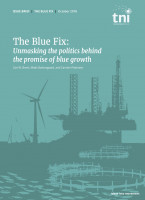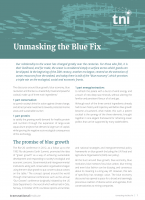Blue Finance: How much debt can the ocean sustain? Implications for coastal fishing communities in South Africa
Regions
Conservation finance claims that the climate and biodiversity crisis must be solved through private financial investors. But can debt save the oceans? This brief looks at what is taking place in bond markets, including blue and sustainability-linked bonds, as well as debt swaps. Although most people have heard about these instruments, many are unsure how they work and their implications. It uncovers that blue financial instruments are far from solving the climate and biodiversity crisis while, instead, exacerbating the debt crisis for already indebted countries.

Downloads
Authors
Highlights:
-
Over the past decade, international strategies for ocean conservation have changed radically. Increasingly, conservation projects are based on raising money through financial markets and are, therefore, intended to provide investors with profitable returns. Many refer to this as ‘blue finance’. International support for this is growing, and it is considered a critical way to bridge an imagined funding gap to save marine biodiversity.
-
What can be understood as the financialisation of conservation has produced so-called innovative financial instruments, including blue bonds and debt for ocean swaps. These are now being heavily promoted in African countries, including South Africa. These have become closely aligned with global ambitions for the 30x30 target. Yet many people are unsure what these financial instruments are and how they work.
-
Blue finance is considered in its early days. However, already US conservation organisations, led by The Nature Conservancy, have refinanced over $2.5 billion in debt for ocean swaps in just five countries. A blue bond is also being pursued for the Great Blue Wall Initiative by the UN, for which South Africa is a partner country. This not only aims to meet the 30x30 target but also propel blue growth and produce thousands of new ‘blue jobs’ across Southern and East Africa.
-
Despite overwhelming international support for blue finance, there are several reasons why blue bonds and debt swaps pose risks to small-scale fishing communities. They can be opaque financial transactions that manipulate the debts of Southern countries, leading to a transfer of wealth and power to unaccountable US conservation organisations, now working in close partnership with investment firms and the banking sector. They further entrench the reckless view that saving nature must produce never-ending profits for the private sector. SSF communities are already wary of the impact of the 30x30 agenda, and the threats this causes may be amplified where this is driven by the needs of private capital.
-
Confronting blue finance is a daunting prospect. The lack of transparency and public participation surrounding these deals must be exposed. So too must the underlying logic of the funding gap. A lack of finance is not the root cause of the biodiversity and climate crisis. These are crises of affluence and short-term profiteering, which are existential problems driven by poorly regulated global financial markets. Lasting solutions that promote livelihoods and food security must, therefore, come from political and cultural change, not through manipulating debt.


